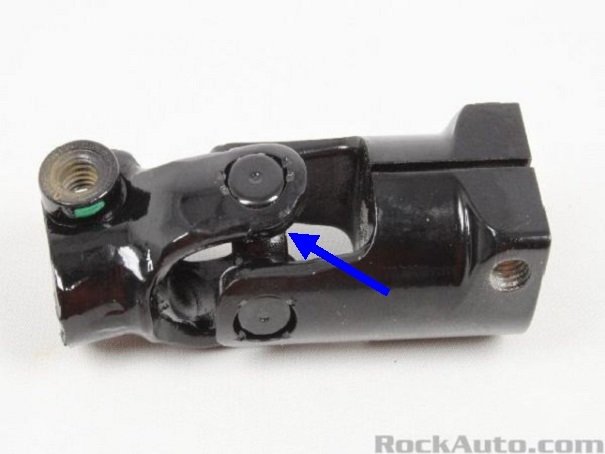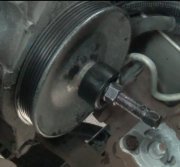Be aware there is supposed to be a small drain hole at the bottom / rear of the muffler for the condensed water vapor to drip out. People not aware of that can make it sound like it's a big deal when it really isn't.
There are so many things related to a shaking steering wheel, but there is always one thing those causes have in common. They have to involve something that is rotating, in this case, tires, wheels, brake rotors, front wheel bearings, and front half shafts. Worn steering and suspension parts can allow that shaking to occur or to be worse, but they don't cause shaking on their own. This article looks at some of these causes:
https://www.2carpros.com/articles/steering-wheel-shakes-when-accelerating-or-braking
The place I would head first is to a tire and alignment specialty shop, and give them a detailed description of what is happening. The people there are experts at finding the causes of clunks, vibrations, and bad tire wear. Very often they will insist on a preliminary test-drive where you go along to point out clues or observations. Here's a link to an article about tire wear problems, but pictures don't do a good job of showing this:
https://www.2carpros.com/articles/how-car-tires-work
A specialist will know exactly where to start looking just by running his hands across the tread and feeling the type of wear that is occurring.
The next thing we look at is how that shaking is being generated. We look for loose parts first, but there are multiple ways the vehicle has to be raised up and supported to do that. When the hoist lifts the vehicle by the frame, the suspension parts hang down freely, and that removes the tension or pressure on the lower ball joints so the wear can be seen by prying on them, but it lets gravity tug on the upper ball joints, and that prevents us from seeing any play in them. Upper ball joints have to be checked with the vehicle sitting on the tires.
Worn tie rod ends are usually very evident from simply grabbing the tire and trying to turn it left and right repeatedly.
Once loose and worn parts have been identified, we look at those rotating parts. One form of warped brake rotors can be felt during the preliminary test-drive. That is "thickness variation". It causes the brake pedal to be pushed up and down against your foot pressure, when the brakes are applied and the vehicle is moving. Think of grasping a dinner plate between your thumb and fingers. The thickness there is different than the thickness on the other side of the plate. When the thicker spot runs past the brake pads, it pushes the pads apart a little. That pushes brake fluid back up to the master cylinder and brake pedal.
"Lateral run out" is another type of warped brake rotor. There may be no thickness variation, but the entire rotor is tipped relative to its center. That causes the brake caliper to be tugged left and right once per wheel revolution. The tugging on that mass can put enough force on the steering linkage to be felt in the steering wheel and the brake pedal.
Often the shaking occurs for the first time right after some other service is performed that involved removing the wheels. If we're machining a brake rotor as part of a standard brake job, if we don't mount it squarely on the brake lathe, we'll machine a warp into it. That can also be caused by overlooking the rust that builds up on the back side in the mounting area. A chunk of that rust can become lodged behind the rotor on the lathe and cause the rotor to wobble while being machined.
Related to that, it is not uncommon for a piece of rust or scale to chip off when we're reinstalling the rotor, and it gets caught between the rotor and hub. That will cause the rotor and the wheel to wobble. It is also real common for chunks of corrosion to break off the back side of cast wheel. When the wheel is reinstalled, that chunk prevents the wheel from sitting squarely against the rotor.
A dial indicator is used to identify a bent wheel and chunks of rust or scale caught between the hub, rotor, and wheel. If excessive lateral run out is found, further inspection will reveal the cause. In this case the dial indicator is used again on the rotor after the wheel has been removed.
One of the problems we run into quite often is having to make judgement calls as to whether a part is worn enough to warrant replacement. By 100,000 miles, no steering or suspension part will be as tight as when it was new, but that doesn't mean we can justify replacing them. You have to remember, we get accused all the time of trying to sell you parts and services that aren't needed. You're accusing someone of just the opposite; so we can't win. With high-mileage vehicles, we could replace all the ball joints, tie rod ends, and control arm bushings, but that cost would show up in a higher sales price and there would be questionable improvement in the handling. The money spent would not be a good value for the dealer or for the buyer.
Part of what you described can also be caused by a bad alignment. If "total toe" is not correct, the two front tires will be steering in slightly different directions. The vehicle will follow the tire with the most weight on it, which is usually the right one. When you hit a bump or pass an intersection, some weight shifts to the left tire, then the vehicle will follow that one momentarily. You'll be constantly correcting the direction of travel.
If you feel something suddenly change or shift, especially when you're part-way through a sweeping curve, something is loose and moving around. Loose or worn mounting hardware for the steering gear, and deteriorated control arm bushings are common causes.
One thing that is often overlooked during a pre-alignment inspection is vehicle ride height. Even if all the numbers look perfect on the alignment computer, if the front springs are sagged below the published legal limit, the entire geometric relationship between the spindle, control arms, and frame will cause the wheels to not tip in and out on top as designed to reduce tire wear and improve handling. In my ten years as the suspension and alignment specialist at a very nice family-owned Chrysler dealership, I saw a lot of Dakotas and Durangos come in with the most miserable alignment readings, and well over nine out of ten ended up perfectly in specs by simply adjusting up the front torsion bars to get ride height back to specs. Every shop has a small book that lists every model and year, where to take the height measurements, and what they should be. Chrysler's method requires taking two readings per corner, then calculating the difference to get the height. While it's slightly more complicated, it eliminates the variable of optional tire sizes. Bigger tires make the truck sit higher off the ground, but that's not what we're after. It's the angles the control arms are sitting at that is important.
Saturday, January 25th, 2020 AT 2:45 PM




